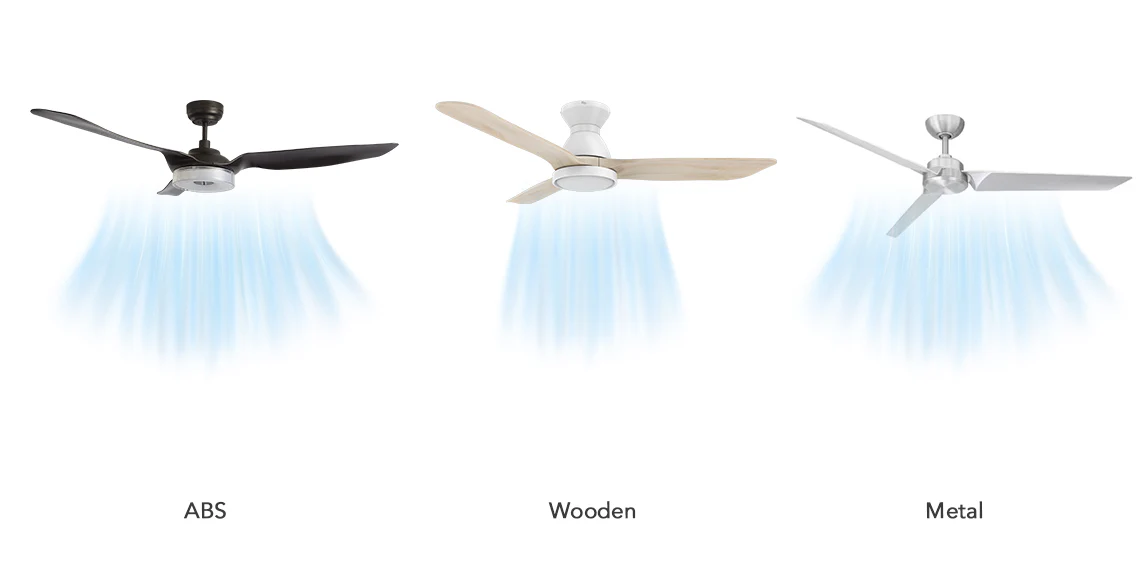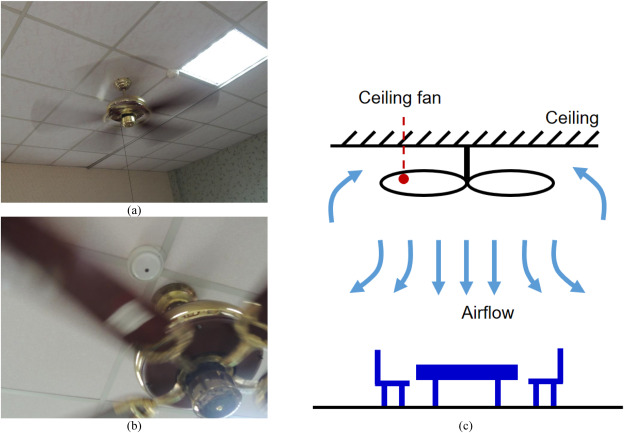As an industrial fan engineer with years of experience in airflow optimization, I’ve often encountered the question: What is a good airflow for a ceiling fan? Knowing what ideal circulation a ceiling fan requires will help you greatly increase your comfort and energy economy, whether you are installing in a big manufacturing facility, office, or even your house. We will explore in this post the elements influencing proper airflow, methods of measurement, and the appropriate airflow range for your environment.

What is a Good Airflow for a Ceiling Fan?
Usually expressed in cubic feet per minute (CFM), airflow in ceiling fans is crucial. A ceiling fan may supply more airflow the higher its CFM. The size of the room, the design of the ceiling fan, and the intended usage of the area will mostly determine a good airflow for the fan. Higher airflow is vital in a factory or big office; in smaller areas, less airflow may be sufficient to keep comfort.
Understanding what is a good airflow for a ceiling fan ensures that you choose the right fan for your specific needs, maximizing cooling efficiency and air circulation while minimizing energy consumption.
Factors Affecting Effective Airflow for a Ceiling Fan
When choosing a ceiling fan, one should pay attention to the following elements influencing airflow:

1. Room Dimensions and Form
The first thing to consider when determining what is a good airflow for a ceiling fan is the size of the room. Bigger spaces, like conference rooms or warehouses, call for fans able to circulate more air. For big rooms, for instance, fans with a CFM rating of 5,000 to 7,000 are perfect; for smaller places, such as offices or bedrooms, fans with a CFM of 2,000 to 4,000 would fit rather nicely.
2. Fan Blade Architecture
The design of the fan blades also influences what is a good airflow for a ceiling fan. Larger blades appropriate for bigger areas usually move more air since they have a better span. Conversely, fans with smaller blades are more appropriate for small rooms but, when utilized properly, they can still offer enough airflow.
If you’re not sure what would be best for your particular location, feel free to get in touch with us personally for the lowest discount prices on industrial-grade ceiling fans with outstanding airflow capacity.
3. Motor Force
A fan’s motor plays a significant role in what is a good airflow for a ceiling fan. Larger areas or locations needing continuous, high-volume air movement will find higher-powered motors perfect since they are made to efficiently circulate air. Stronger motors generally make sense for spaces with high ceilings or rooms seeing lots of foot traffic.
4. Fan Speed Ranges
Because they govern the speed at which the fan blades rotate, fan speed settings impact airflow. Though variable speed controls offer more exact airflow adjustment, three-speed options (low, medium, and high) are usually available. Larger areas sometimes need high-speed settings to obtain the best airflow.
If you require specialized advice for your space, get in touch with us for the best discount rates on high-performance ceiling fans catered to your airflow need.
5. Accuracy of Air Circulation
The direction of airflow determines how efficiently air moves in a room. Summertime ceiling fans should spin counterclockwise to produce a breeze that cools the room. Reversing the direction to clockwise helps to move warm air from the ceiling to the floor, therefore improving heating efficiency in winter.
Calculating Airflow in a Ceiling Fan
So, what is a good airflow for a ceiling fan in your space? Although knowing how to measure it is equally crucial, the CFM rating of a fan is the best indication of airflow.
An anemometer or airflow meter will help you to find the volume of air the fan moves across a specified period. Many ceiling fan companies offer CFM ratings based on a fan’s speed and blade design, which might guide your choice of a fan.

Typical Questions About Ceiling Fan Airflow
1. What is a good airflow for a ceiling fan in a large room?
A ceiling fan rated 5,000 to 7,000 is best for a big room. This range guarantees good air circulation, maintaining the comfort of the space.
2. How can I find out whether my ceiling fan is delivering enough airflow?
Should your fan not be turning enough air, the room can seem heated or stuffy. To be sure the fan is suitable, find its CFM rating and then compare it with the size of the room. If you’re not sure which fan fits your room, please get in touch with us for the most discounted rates.
3. Is there any way I may increase airflow in my room without changing my fan?
Indeed, maximizing fan location and guaranteeing clean, garbage-free blades will help to increase airflow. Furthermore, improving circulation is possible by changing the speed of the fan.
4. For my space, what size ceiling fan should I get?
Fans with 1,000 to 3,000 CFM perform effectively for small spaces (up to 75 square feet). Large spaces call for fans with 5,000+ CFM; medium-sized rooms (75–175 sq ft) call for fans with 3,000–5,000 CFM.
5. Do low-profile ceiling fans provide enough good airflow?
Indeed, low-profile ceiling fans can offer great airflow—especially for low-ceiling areas. Get in touch with us for the best low-profile fans intended for effective air circulation at discounted rates.
En resumen
Choosing the correct ceiling fan for your environment depends on knowing what a good airflow one offers. Ensuring appropriate airflow will significantly affect comfort and energy economy, whether you’re outfitting a tiny office or a big manufacturing plant. You may pick a fan that fits your demands and provides the best performance by weighing elements such as room size, fan blade design, motor power, and fan speed.
Get in touch with us right now for the greatest discount prices on our selection of high-performance fans made to fit the particular requirements of your company if you are ready to invest in a ceiling fan with the best airflow for your area.
Referencias
- “Choose the Right Ceiling Fan: A Guide to Airflow and CFM”, EnergyStar.gov
- Ceiling Fan Airflow: How to Choose the Best Fan for Your Room Size, The Home Depot
- “Airflow and Ceiling Fans: How to Measure and Improve Air Circulation”, CeilingFan.com
Póngase en contacto con nosotros para obtener asesoramiento experto.
- Correo electrónico: info@blowox.com
- Visita: blowox.com




Top 10 Best Outdoor Patio Ceiling Fans to Beat the Heat in 2025
Having the best outdoor patio ceiling fan will make all the difference in how much [...]
Top 10 Best 3 Blade Ceiling Fans for Modern Homes in 2025
Finding the best 3 blade ceiling fan can transform the ambiance and comfort of your [...]
Reviews, Features, and Shopping Advice for 2025’s Best Modern Ceiling Fans
Modern ceiling fans have evolved from a mere cooling solution to a statement of efficiency [...]
How to Operate a Ceiling Fan: Expert Tricks to Save Money and Stay Cool
More than merely ornamental accents, ceiling fans are reasonably priced means of improving comfort and [...]
Top 10 Cheap Outdoor Ceiling Fans That Offer Style and Durability in 2025
Finding the ideal cheap outdoor ceiling fan does not mean you have to give up [...]
Does Leaving a Ceiling Fan On Waste Electricity? 5 Surprising Facts You Should Know
Many homes find ceiling fans to be the go-to fix for home comfort. Still, a [...]
Does Reversing a Ceiling Fan Make It Warmer? The Winter Home Hack You Need to Know
Homeowners sometimes look for creative solutions to keep their houses comfortable without going broke as [...]
Does Reversing a Ceiling Fan Work? The Winter Energy Hack You Need to Know
Heating bills can explode when temperatures fall. You might be asking: Does reversing a ceiling [...]
Does Running a Ceiling Fan Help with Air Conditioning? 5 Surprising Benefits You Need to Know
Maintaining coolness in your environment may be both a need and a comfort throughout summer. [...]
The Ultimate Guide to Choosing the Best Ceiling Fan for Small Room
Choosing the Best Ceiling Fan for Small Room will revolutionize the comfort and design enhancement [...]